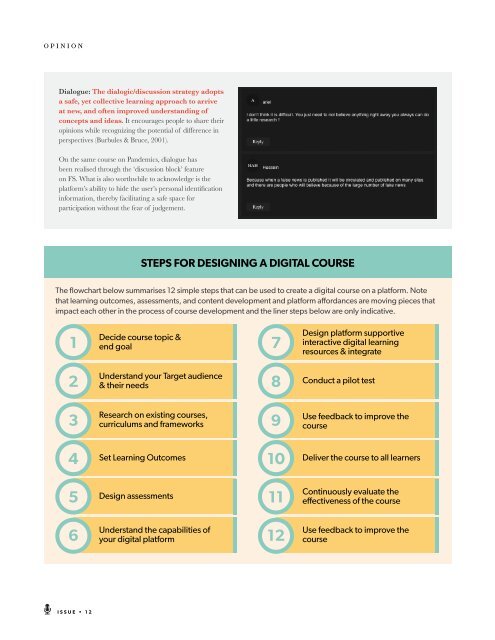The Blue DOT - 12: Reimagining Learning Spaces for Uncertain Times
You also want an ePaper? Increase the reach of your titles
YUMPU automatically turns print PDFs into web optimized ePapers that Google loves.
Dialogue: <strong>The</strong> dialogic/discussion strategy adopts<br />
a safe, yet collective learning approach to arrive<br />
at new, and often improved understanding of<br />
concepts and ideas. It encourages people to share their<br />
<br />
perspectives (Burbules & Bruce, 2001).<br />
On the same course on Pandemics, dialogue has<br />
been realised through the ‘discussion block’ feature<br />
on FS. What is also worthwhile to acknowledge is the<br />
<br />
in<strong>for</strong>mation, thereby facilitating a safe space <strong>for</strong><br />
participation without the fear of judgement.<br />
Conclusion<br />
<strong>The</strong>re is an increasing recognition of the power of digital<br />
pedagogies to augment learning in K-<strong>12</strong> as well as higher education<br />
globally. However, this integration needs to be executed<br />
with caution; mere uptake of technology may not help<br />
in achieving the much sought-after pedagogical ideas of<br />
personalization, collaborative learning, enquiry based<br />
learning or continuous assessments. Just as great content<br />
knowledge requires sound pedagogy <strong>for</strong> impactful learning, digital<br />
competencies of educators need to be enhanced so that they can<br />
<br />
meaningful online learning. <br />
OPINION<br />
STEPS FOR DESIGNING A DIGITAL COURSE<br />
<strong>The</strong> flowchart below summarises <strong>12</strong> simple steps that can be used to create a digital course on a plat<strong>for</strong>m. Note<br />
that learning outcomes, assessments, and content development and plat<strong>for</strong>m af<strong>for</strong>dances are moving pieces that<br />
impact each other in the process of course development and the liner steps below are only indicative.<br />
REFERENCES<br />
1<br />
Decide course topic &<br />
end goal<br />
7<br />
2<br />
Understand your Target audience<br />
& their needs<br />
8<br />
3<br />
Research on existing courses,<br />
curriculums and frameworks<br />
9<br />
4<br />
Set <strong>Learning</strong> Outcomes<br />
10<br />
5<br />
Design assessments<br />
11<br />
6<br />
Understand the capabilities of<br />
your digital plat<strong>for</strong>m<br />
<strong>12</strong><br />
Design plat<strong>for</strong>m supportive<br />
interactive digital learning<br />
resources & integrate<br />
Conduct a pilot test<br />
Use feedback to improve the<br />
course<br />
Deliver the course to all learners<br />
Continuously evaluate the<br />
effectiveness of the course<br />
Use feedback to improve the<br />
course<br />
Burbules, N. C., & Bruce, B. C. (2001). <strong>The</strong>ory and research on<br />
teaching as dialogue.<br />
Burguillo, J. C. (2010). Using game theory and competition-based<br />
learning to stimulate student motivation and per<strong>for</strong>mance. Computers<br />
& Education, 55(2), 566-575.<br />
Brudner, E., (2019). <strong>The</strong> neuroscience behind storytelling in sales.<br />
Hubspot. Retrieved from https://blog.hubspot.com/sales/theneuroscience-behind-storytelling-in-sales-infographic#sm.00001e8f98<br />
02uqfkcyupxelm9sxsd<br />
Dede, C., Salzman, M., Loftin, R. B., & Ash, K. (2000). <strong>The</strong><br />
design of immersive virtual learning environments: Fostering deep<br />
<br />
& R. B. Kozma (Eds.), Innovations in science and mathematics<br />
education: Advanced designs, <strong>for</strong> technologies of learning (p.<br />
361–413). Lawrence Erlbaum Associates Publishers.<br />
Hubbs, D.L. and Brand, C.F., 2005. <strong>The</strong> paper mirror:<br />
<br />
Education, 28(1), pp.60-71.<br />
Koepp, M. J., Gunn, R. N., Lawrence, A. D., Cunningham, V. J.,<br />
Dagher, A., Jones, T., & Grasby, P. M. (1998). Evidence <strong>for</strong> striatal<br />
dopamine release during a video game. Nature, 393(6682), 266.<br />
M. K. Smith1,*, W. B. Wood1, W. K. Adams2, C. Wieman2,3, J. K.<br />
Knight1, N. Guild1, T. T. Su1 (2009). Why Peer Discussion Improves<br />
Student Per<strong>for</strong>mance on In-Class Concept Questions. Science<br />
02 Jan 2009: Vol. 323, Issue 5910, pp. <strong>12</strong>2-<strong>12</strong>4, DOI: 10.1<strong>12</strong>6/<br />
science.1165919<br />
Muntean, C. I. (2011). Raising engagement in e-learning through<br />
<br />
ICVL, 1.<br />
<br />
<strong>Learning</strong>, by Charles Hodges, Stephanie Moore, Barb Lockee, Torrey<br />
Trust and Aaron Bond, Published: Friday, March 27, 2020<br />
ThinQ. (2014). School of ThinQ. Retrieved from http://www.<br />
schoolofthinq.com/<br />
Universal Design <strong>for</strong> <strong>Learning</strong>, Essay by Maya Eagleton, Ph.D.,<br />
EBSCO Research Starters, Copyright (2008), EBSCO Publishing Inc.<br />
Valerie J. Shute (2013). Measuring and Supporting <strong>Learning</strong> in<br />
Games: Stealth Assessment. DOI: 10.7551/mitpress/9589.001.0001<br />
<br />
Assessment In Teaching from Iraqi Instructors Points of View. AL-<br />
Fatih Journal<br />
Zak, P. J. (2015). Why inspiring stories make us react: <strong>The</strong><br />
neuroscience of narrative. In Cerebrum: <strong>The</strong> Dana <strong>for</strong>um on brain<br />
science (Vol. 2015). Dana Foundation.<br />
ISSUE • <strong>12</strong><br />
5 7


















